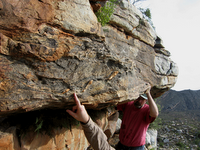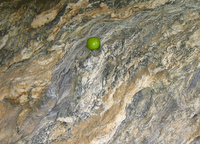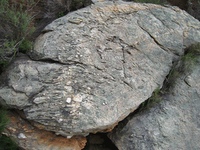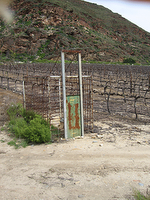Good stuff here folks. Chris Harris came out to Laingsberg on Thursday morning to pick me up and we drove through the Cape Fold Belt to the syntaxis area in the wine country around Worcester. Awesome! The strata are of the same groups as those in Cape Town - preCambrian Malmesbury Group (turbidites), sub-vertical, unconformably overlain by the Table Mountain Group - massive sandstones, with rare shale interlayers. All well and good. In the syntaxis, the unconformity itself is folded and thrusted, north-vergent, and as one would expect there is substantial deformation of both formations. The style, however, is very different. The rocks are low greenschist facies probably - chloritoid? maybe 300C. Brittle-ductile transition!!! OK let's look at a few.

This is low in the Table Mountain Group (near base of Peninsula Fm), offset veins suggesting top-to-north vergence. So far so good! This is a highly deformed layer of schist in between basically undeformed quartzites. That's Brian Turner from Durham pointing at it. He's here to teach South African Stratigraphy in the next modules.

But wait! Just a few meters away, there is a very similar structure, but it is retrodeformed to Delta-structure - normal-sense backsliding on the same layer. OK I guess that's fine. A little surprise but still fine. Then I took a look at all the veins crossing the shear zone at a high angle (not pictured). At first I thought they must be R-shears but I took another look and they really look like tensile fractures suggesting normal motion. OK still fine, the thing was thrust, and then had a tiny bit of normal motion, at the same metamorphic grade. Max grade probably. OK moving on.

And nearby that site, we found a big bolder of breccia. Clasts are clearly quartzite, the matrix looks like ground-up Malmesberry Shales, still good - but brittle now.

In a cave in the lower Penninsula Fm, we find a similar looking ... "breccia"... but it contains clasts which look more rounded. And some of those clasts are NOT quartzite. Like the boulder of yellowish chert. OK... Could be a conglomerate bed.

We climbed up another hillside to find the contact. By this point we were discussing whether the unconformity had maybe been activated as a major thrust of the system. Then we found this: Massive lineated quartz veins along the surface, some of which (in the footwall), are brecciated! and that breccia is ductiley deformed! Clast boundaries appear stylolitic. Neato! And at the base of the Penninsula Group - a quartz pebble conglomerate.

Naturally all this required that we climb up a bunch more rocks into a baboon cave to see if we could continue to find the contact - note folds above!

And what we found - a thin layer of strange angular conglomerate and/or breccia? What is that? Looks like a rounded clast above - in the overhanging base of the hanging wall. So which is it?

And at a very tight (isoclinal) fold in the contact, we find the Penninsula Fm. in the core, with a beautiful quartz pebble bed only a few 10s cm above the base. Check out the axial planar cleavage defracting through the pebble bed! Whoa yah!
In case it's not clear why I'm belaboring the conglomerate vs. breccia issue - some students have mapped a big huge thrust here. Others have mapped a late normal fault here. Still others have no structure here - it's just a bed. Hmm. Not my problem fortunately because I am not marking these. But it seems to me that it's a fault developed along an unconformity where there are discontinuous pebble and boulder conglomerate lenses at the base of the quartzites. That might be a little much for a 2nd mapping project! We'll see what happens.

Like I said, it's just like the Napa Valley. Sunshine, vineyards as far as the eye can see. And of course, the Baboon traps.

And it looks like I'm not the only Banana Slug out in Worcester today. What's this guy doing here?



No comments:
Post a Comment